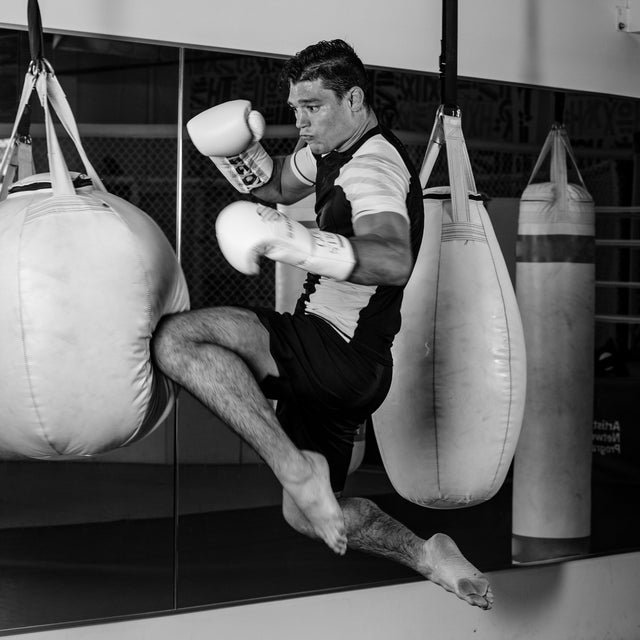Basic Striking: Knee Strikes
When it comes to striking in combat sports, there are a variety of strikes that a fighter can have in their arsenal. Punches, kicks, elbows, knees are the most commonly used strikes due to their effectiveness. This article will examine knee strikes.
Knee strikes are a very dangerous tool for a fighter to have in their arsenal. One knee strike can do a significant amount of damage in a fight. Like elbows, knee strikes can do significant blunt force damage at close range (such as in the clinch).
NOTE: Knee strikes should be practiced (1) on pads, (2) on the heavy bag, or (3) when shadowboxing.
Knees should NOT be practiced during sparring… UNLESS they are thrown in a controlled manner. These are powerful strikes that can do a lot of damage, so keep this in mind and take care of your training partners.
Rear Knee
1) To throw the rear leg knee strike, step forward with your lead foot and extend your rear arm in front of your body to measure the distance between you and your target.
Not only does this help close the distance between you and the target, but this will start your body on a path of forward momentum - which will be converted to power upon landing the strike.
This will help you keep the distance that you want; if your opponent moves back, you will clearly see that they have retreated away from your hand and if they move forward to try and disrupt your timing, your outstretched arm can be used as a frame to keep them where you want.
2) After judging the distance, you will be able to determine if they are within striking distance.
If they have moved out of range, no worries - you are still in your fighting stance.
3) If they are in range, you will push off of the ground with your back leg and step up to the ball of your base (lead) foot.
4) Once on the ball of your base foot, the rear leg knee will thrust forward, up and into the target.
On the way to the target, bend the back knee so that the calf connects to the hamstring - this will help ensure that the knee will be the first thing to connect with the target and nothing else interferes.
5) The extended arm first used to judge the range will swing down and backward as the knee is sent forward.
The hand path will start around head level and end near your own hip/butt.
6) To generate more power and ensure that no power is lost as the knee strike is thrown, extend the hip flexor of the base leg (the one planted on the ground) and lean back with the upper half of your body, ensuring that your momentum is still carrying you forward.
This occurs simultaneously with the previous step (as you swing your arm back, your knee and same side hip will go forward).
Throughout this entire technique, the lead hand should always be up guarding your head/chin and your chin should be tucked.
Lead Knee
The process of throwing the lead knee, and any knee, is generally the same as throwing the rear knee. Follow the steps of throwing the rear knee and adapt it to fit the side you want to throw it on.
For example, where you may step forward with the lead leg to start the process of throwing the rear knee, you may choose to step forward with the rear leg when throwing your lead leg knee. The mechanics of the technique are essentially the same, only varying on the side you follow them from.
To throw these knees, you may need to adapt this step-by-step guide based on the situation. If you are very close to your opponent, such as in the clinch with them, you may find that you don’t need to take a step forward before throwing the knee (step 1). You may just want to step up on the ball of your base foot (step 3) and throw the knee. Adapt this guide to the situations you find yourself in and use what you think is necessary, while discarding what may not be useful.
Side Knee
1) To throw a side knee, bring your knee up to the height of your hip (at least). If you have better mobility in your hips, you can choose to raise your knee higher (ex. to your chest).
When you raise your knee, raise it out to the side of your hip - you will be bringing it in to connect with your target when you throw the side knee.
The inside part of your thigh should be pointing at your target.
2) While this happens, you will step up to the ball of your base foot (the one on the ground not throwing the knee).
3) With your raised knee, you will bring it in toward your centerline and slam into your target with the inside part of the knee.
Which part of the knee is this exactly? Touch the front of your knee. Now shift 90 degrees toward the inside of your knee. You should feel a bone around this area. That is the part you will be landing with.
4) After connecting, use the impact to push off with the landed knee and retrace the path it originally took and go back into your fighting stance. If you choose to drop the foot after landing the side knee, you will be very close to your opponent, so be cautious of any incoming strikes or sweeps from the clinch.
Things to keep in mind:
The range-finding arm does not always have to be fully outstretched - with more experience, you will be able to judge the distance better (which may eliminate the need to reach out at all)
The amount of area that the calf will cover the hamstring will vary based on distance.
Generally, the closer you are to your target, the less calf-hamstring connection there will be. The further away the target, the more the hamstring will cover the calf during the knee strike.
Some fighters prefer to point the toes when throwing the knee strike (by flexing their ankle back), while others prefer to leave them relaxed. So what is better? There is no “right answer” - do whichever is more comfortable for you.
In addition, some fighters choose to swing their leg all the way back before bringing the knee up to their hip. Throwing your leg behind you will load the hip and give the knee strike a lot more power. Watch the video of Superlek throwing knees for a great example, linked below.
These knee strikes can be done with BOTH the lead and rear legs because the mechanics behind these strikes are basically the same.
The techniques of each knee will need to be adjusted based on the distance and defense of your opponent, but the mechanics remain constant.
To cover more distance and increase power when throwing knees, fighters may choose to hop forward with their base foot (the foot that will be planted on the ground when the knee is being thrown) and then proceed to throw the knee. This gives the resulting knee more forward momentum, which means more power will be generated in the knee. This hop is not always necessary, as there are times where a simple step toward the target with the base foot will work instead of a small hop.
When to use
Due to the effectiveness of knees, fighters often use this strike during competition. Knee strikes are mainly used to do damage at close range, close the distance, enter the clinch, do damage in the clinch, or to break the clinch (or opponent’s grip on you). In other words, knees are thrown either for pure damage or as an entry strike to transition into grappling (clinching in Muay Thai or wrestling/BJJ in mma). Knee strikes are a good option to deter opponents from closing the distance on you and disrupting their rhythm and timing. They can also be used at medium to far ranges, as a step/hop may be used to quickly close distance and then deliver the knee. They are great for weakening an opponent’s guard and breaking their posture. Once one (or both) of these possibilities occur, knee strikes have now caused enough damage to the body to open up more powerful strikes to the head or legs.
When throwing knees in training, here is a short guide on what to connect with (to avoid any real damage in training before a fight):
“Normal” knee (where the front of the knee connects with the target): connect with the quad/front of your thigh… OR connect with a knee in a controlled manner
Side knee: hit with inside of the thigh… OR connect with the inside part of the knee in a controlled manner
Attached are some videos to help you with your knee strikes:
Knee strikes with Superbon: https://www.youtube.com/watch?v=h1mDK4VF7NQ
Side knee: https://www.youtube.com/watch?v=au1nsG1AWnU
Superlek knees the heavy bag: https://www.youtube.com/watch?v=drfLNGDnrF4 (11:00)
Example of how to spar with knees (Superbon clinch fighting): https://www.youtube.com/watch?v=CjMr9INQJXI
Thank you for reading - we hope this article effectively covers the basics of the knee strike!





0 Comments
There are no comments for this article. Be the first one to leave a message!